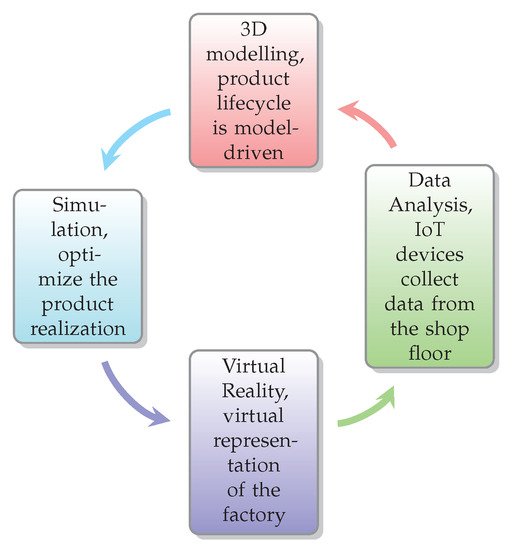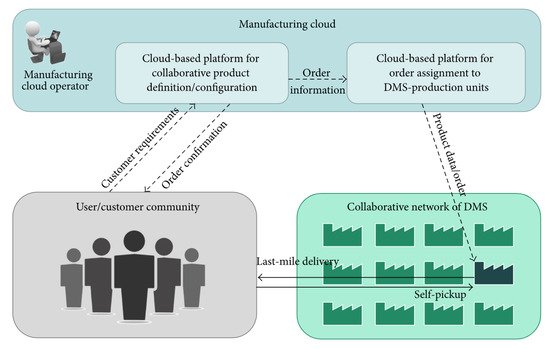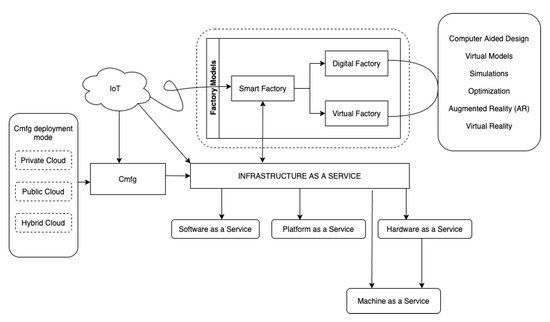
| Version | Summary | Created by | Modification | Content Size | Created at | Operation |
|---|---|---|---|---|---|---|
| 1 | Letizia Leonardi | + 2688 word(s) | 2688 | 2021-11-01 05:19:36 | | | |
| 2 | Beatrix Zheng | + 27 word(s) | 2715 | 2021-11-05 11:57:28 | | |
Video Upload Options
A digital factory refers to a new type of manufacturing production organization that simulates, evaluates, and optimizes the production processes and systems. Digital factories are not confined only to the production stage; instead, they extend to address the entire product lifecycle.
1. Introduction
The digitalization of a factory is deeply impacted by the new trends emerging under the umbrella of programs developed in the on-going fourth industrial revolution, which aims to automatize traditional manufacturing process and systems, taking benefits from the modern technologies developed by the ICT. Digitalization includes the application of technologies at a different scale, shifting from software downing to infrastructure, and systems to revolutionize traditional production processes and business. In this scenario, different programs have emerged to identify major trends in the digitalization of a factory. Thanks to our involvement in the FIRST H2020 project (vF Interoperation suppoRting buSiness innovaTion) ( https://www.h2020first.eu , accessed on 24 October 2021) , we had experience concerning the European program Industry 4.0 and the Chinese program China 2025; the FIRST project is a mobility project that involves European and Chinese universities and companies, focusing on virtual factories. We did not find a comparison in the literature between the two programs, in our opinion because of the difficulties of consulting Chinese documents and repositories, so we decided to compare them. Therefore, in this review paper, we report about our work. European industrialists identify the radical change in the traditional manufacturing production process as the rise of Industry 4.0 [1]. Conversely, China mainland launched its strategic plan China 2025 to promote smart manufacturing as an objective for digitalizing traditional manufacturing processes.
Industry 4.0 and China 2025 programs share the goal of realizing the next Factory of the Future towards the development of an ICT-enabled intelligent manufacturing [2][3]. In these two programs, the link between industrial machines, humans, and manufacturing systems is achieved by forming virtual collaborative networks to quickly respond to the market changes supported by Cyber-Physical Systems (CPS) as the system’s backbone. They enable the integration of all resources related to the manufacturing process. The traditional Product Lifecycle Management (PLM) is the process of managing the entire product lifecycle of the supply chain. This process ranges from the preliminary activity, such as product prototyping, down to product design and its realization. Data originated from the activities of PLM mainly focuses on physical products rather than virtual models. The lack of convergence between physical products and virtual models gets data in the product lifecycle isolated, fragmented, and stagnant, which is useless for manufacturing enterprises [4]. In this scenario, Cyber-Physical Systems (CPS) have the central role of enabling a digital twin model. One of the key aspects of the digital twin model is establishing a link between physical products and virtual models. The digital twin model enables the designer to test, predict, and verify product performance by simulating a design scheme and manufacturing process before diving into the production process. A general definition of the Digital Twin model is given by [5] as: “Digital twin model is an integrated multi-physics, multi-scale, probabilistic simulation of a complex product and uses the best available physical models, sensor updates, to mirror the life of its corresponding twin”.
To this end, the digital twin model consists of three parts. A physical part where products and manufacturing assets compose the existing shop floor layer. A virtual part where virtual models of products and manufacturing assets enable constructing a virtual model to test, simulate, and verify product performances. The last part is a link between the physical layer and the virtual layer to synchronize and integrate the physical and the virtual world. To address this new shortcoming, a paradigm shift is needed to build the next generation of Factory of the Future.
The digital-twin-driven manufacturing process enables industries to face new challenges arisen from the change of market requirements. For example, the new emerging trend known as product mass customization puts final customers at the center of the manufacturing process by allowing mass customization of products. The driven digital-twin manufacturing process fits these requirements by allowing industries to rapidly change manufacturing processes or customize them according to customer requirements. The implementation of the digital twin model is addressed at different layers of the supply chain.
2. Characteristics of Digital Factory
To this end, the digital twin model is based on different models representing physical manufacturing assets (i.e., 3D-model, discrete event model) and virtual simulation technology to simulate and predicts the performance of virtual models, as well as an integration platform to realize two-way connectivity between digital and real factory [6].
One of the significant concepts of a digital factory is representing the physical objects composing the shop floor in a virtual space. The connection between the physical and the virtual world of a factory is realized through virtual models [7].
For a smart factory, the digital factory represents a necessary prerequisite for its enablement. A smart factory is, in turn, necessary for the development of the next generation of smart manufacturing. Within a smart factory, the digital factory’s capabilities are improved by adding an extra layer that provides real-time data from the shop floor, thus simplifying the construction of faithful 3D models of the digital factory. The shop floor data collection enables the digital factory to better design models, improving accuracy as well as simulation results (see Figure 1).

In implementing a Smart Factory system, the Internet of Things (IoT) plays a key role. IoT sensors’ data sensing enables the digital factory to enrich virtual models with real-time data inferred from the shop floor. Sensing capabilities improve model accuracy as well as provide real-time statistics about the manufacturing process of the supply chain. A sensing layer links the smart factory with existing applications of digital factories.
3. Characteristic of Cloud Manufacturing
Cloud manufacturing is an emerging trend popular in China, which benefits from cloud computing and information technology to achieve resource-sharing across small and medium-sized enterprises (SMEs). It has become a national trend due to rapid industrialization and the advancement of information technology. Cloud Manufacturing can be defined as a model for enabling ubiquitous, convenient, on-demand network access to a shared pool of configurable manufacturing resources (e.g., manufacturing software tools, manufacturing equipment, and manufacturing capabilities) that can be rapidly provisioned and released with minimal management effort or service provider interaction [8]. Therefore, on-demand services, resource virtualization, and decentralized services of centralized resources promote new networked manufacturing forms to respond quickly to unpredictable demands of the market. Cloud Manufacturing inherits the concept of “everything is a service” from cloud computing. It proposes a new paradigm of Manufacturing as a Service (MaaS), which encapsulates manufacturing assets (software tools, production systems, capabilities) into cloud services providing on-demand access to consumers. Further, cloud manufacturing promotes a new collaborative manufacturing business model, represented in Figure 2 . Collaborative cloud manufacturing promotes the active role of the customers during the production process. Customers interact with manufacturers via a cloud platform by specifying their product requirements. Mass customization of products is enhanced by creating a network of enterprises Distributed Manufacturing Systems (DMS), having different roles in the production process.

The nature of services provided in the cloud is extremely variegated due to the necessity to cover the traditional manufacturing processes and the related products life cycle. According to [10], service delivery models (SDM) are typical of Cloud Computing, and they can be divided into: Infrastructure-as-a-Service ( IaaS ), Platform-as-a-Service ( PaaS ), and Software-as-a-Service ( SaaS ). In contrast to traditional cloud computing, services are provided both by cloud computing resources and manufacturing resources (smart robots, production systems, equipment). Services provided by the cloud can range from pure manufacturing services (i.e., equipment for product realization) to manufacturing software services (provided through a cloud computing resource). Cloud delivery models fit accordingly to the different manufacturing steps. As an example, considering the product life cycle, the following delivery models are suitable for the different production stages: Product Design, Product Simulation, and Product Management delivered as SaaS Product Planning delivered as PaaS Product Realization (requiring the use of physical equipment composing the factory floor) delivered as IaaS
In addition to the standard cloud manufacturing services mode, cloud manufacturing promotes a new form of enterprises collaboration through the on-demand access of virtualized and decentralized resources via a cloud platform. For example, virtual enterprises set up a collaborative network that supports a different form of coupling, such as loose and tight coupling. According to the diverse enterprise needs, loose coupling is selected for occasional use of manufacturing assets, while a tight coupling is chosen whenever a global manufacturing process relies on services offered by multiple enterprises. Therefore, a cloud architecture promotes enterprise collaboration by enabling multiple forms of alliances according to diverse needs. Through the unified management of resources/capabilities, cloud manufacturing promotes the sharing of decentralized resources of manufacturing resources/capabilities highlighted by the manufacturing grid and includes integrating and sharing hard manufacturing resources.
Cloud manufacturing has four typical deployment modes inherited from cloud computing [8] ( public cloud, private cloud, hybrid cloud, and community cloud). In the public cloud, service providers subscribe and publish their services in a multi-tenant environment. A cloud platform provides on-demand use of services to an open community of customers. Private cloud restricts the operational mode within enterprises boundaries. In a private cloud, all actors belong to the same organization. A community cloud is shared among companies which group together sharing the infrastructure. Hybrid cloud mixes the previous mode to integrate different types of cloud (e.g., public, private). Forming a bridge between different clouds requires cloud owners to select proper resources sharing models. Authors in [11] proposed a framework for the development of hybrid cloud, bridging multiple cloud platforms.
4. Building Blocks of a Factory of the Future
After the analysis of each paradigm, we derive a reference framework for the realization of the digital twin model. Figure 3 reports the analyzed paradigms as well as the contribution to the realization of the factory of the future. The results highlight new features on different levels: IoT technologies are the core system for real-time data analysis and smart sensing and perception. This layer serves others layer as a data producer. Virtual models of the Digital Factory can benefit from the real-time data collected from the shop floor to enable virtual modeling of the real factory simulation and verification of the production processes. On the Digital Factory side, the digitalization of the intra-factory level opens up a new form of virtualization through the adoption of a 3D model-driven production (CAD), Augmented reality (AR), and Virtual Reality.

Conversely, the IoT plays a key role also for the realization of the Cmfg. Shifting from the intra-factory to the inter-factory levels where factories’ capabilities are offered as a service, IoT enables a multi-model abstraction of factories’ assets to govern the digital factory operations. In the Cmfg, each manufacturing resource is abstracted and exposed as a Service according to the principles of Cloud Computing, enabling new forms of collaboration. Collaborative production, tracking materials, and shared production processes are enabled by the implementation of Cmfg platforms. As discussed previously, Cmfg is promoting the enablement of a new form of manufacturing processes, from which the concept of Service emerges. Hard manufacturing resources are abstracted in order to be offered and traded on Cmfg platforms as services. These platforms have different deployment models and enable collaboration on a different scale. Private Cloud refers to a Cloud infrastructure of exclusive usage of a single manufacturer. This option is suitable to benefit from the advantages of Cloud computing without offering services to external actors. On the contrary, Public Cloud is the deployment model enabling the shares of services. Public Cmfg infrastructure can be accessed by consumers to acquire and utilize a variety of services. These services can be in the form of software, platforms, or hardware. This deployment model is the most promising to the enablement of a new form of collaborative manufacturing process since its possible to open up services at an inter-factory level. Hybrid Cloud is a mixed model between public and private modes. As an example, a hybrid Cloud enables factory federation. Multiple factories can agree on sharing common infrastructure and build an exclusive platform on top of it where they execute their manufacturing process. This model opens up the concept of federated Cloud, in which companies organize their own process on the Cloud without actually offering services to the external entities. This form of collaboration is restricted at factory levels without going on public services. Meanwhile, there are multiples challenges to be addressed in order to realize a complete architecture for the digital-twin. Model accuracy and fidelity require a high and complete synchronization between virtual and real shop floor. This requires each entity of the shop floor to be mapped in the virtual space. As seen previously, this requires a high degree of interoperability between system entities, which is not always possible due to the high heterogeneity of technologies nowadays deployed on the shop floor and due to lack of standards. The role of the data in the digital twin model must be studied. New trends in Big Data and Deep Learning must be taken into account in order to maximize model simulations and optimization of design processes, but also for predicting failures and maximize the production processes. In this sense, models for smart analysis and prediction for manufacturing processes must also be studied in relation to computing capabilities enabled by the Cmfg.
5. Final Remarks
5.1. Discussion
5.2. Conclusions
References
- Hozdić, E. Smart factory for industry 4.0: A review. Int. J. Mod. Manuf. Technol. 2015, 7, 28–35.
- Li, L. China’s manufacturing locus in 2025: With a comparison of “Made-in-China 2025” and “Industry 4.0”. Technol. Forecast. Soc. Chang. 2018, 135, 66–74.
- Terkaj, W.; Tolio, T. The Italian Flagship Project: Factories of the Future. In Factories of the Future: The Italian Flagship Initiative; Springer International Publishing: Cham, Switzerland, 2019; pp. 3–35.
- Tao, F.; Cheng, J.; Qi, Q.; Zhang, M.; Zhang, H.; Sui, F. Digital twin-driven product design, manufacturing and service with big data. Int. J. Adv. Manuf. Technol. 2018, 94, 3563–3576.
- Glaessgen, E.; Stargel, D. The digital twin paradigm for future NASA and U.S. air force vehicles. In Proceedings of the 53rd AIAA/ASME/ASCE/AHS/ASC Structures, Structural Dynamics and Materials Conference 20th AIAA/ASME/AHS Adaptive Structures Conference 14th AIAA, Honolulu, HI, USA, 23–26 April 2012.
- Shoudian, L. Discussion on Digital Factory Construction Plan. Manufacturing Automation. Manuf. Autom. 2018, 40, 109–114.
- Nikolakis, N.; Alexopoulos, K.; Xanthakis, E.; Chryssolouris, G. The digital twin implementation for linking the virtual representation of human-based production tasks to their physical counterpart in the factory-floor. Int. J. Comput. Integr. Manuf. 2018, 32, 1–12.
- Xu, X. From cloud computing to cloud manufacturing. Robot.-Comput.-Integr. Manuf. 2012, 28, 75–86.
- Rauch, E.; Seidenstricker, S.; Dallasega, P.; Hämmerl, R. Collaborative Cloud Manufacturing: Design of Business Model Innovations Enabled by Cyberphysical Systems in Distributed Manufacturing Systems. J. Eng. 2016.
- Yongkui, L.; Lijun, W.; Wei, W.; Xun, X. Discussion on cloud manufacturing. China Mech. Eng. 2018, 18, 2226–2237.
- Lu, Y.; Xu, X.; Xu, J. Development of a Hybrid Manufacturing Cloud. J. Manuf. Syst. 2014, 33, 551–566.




